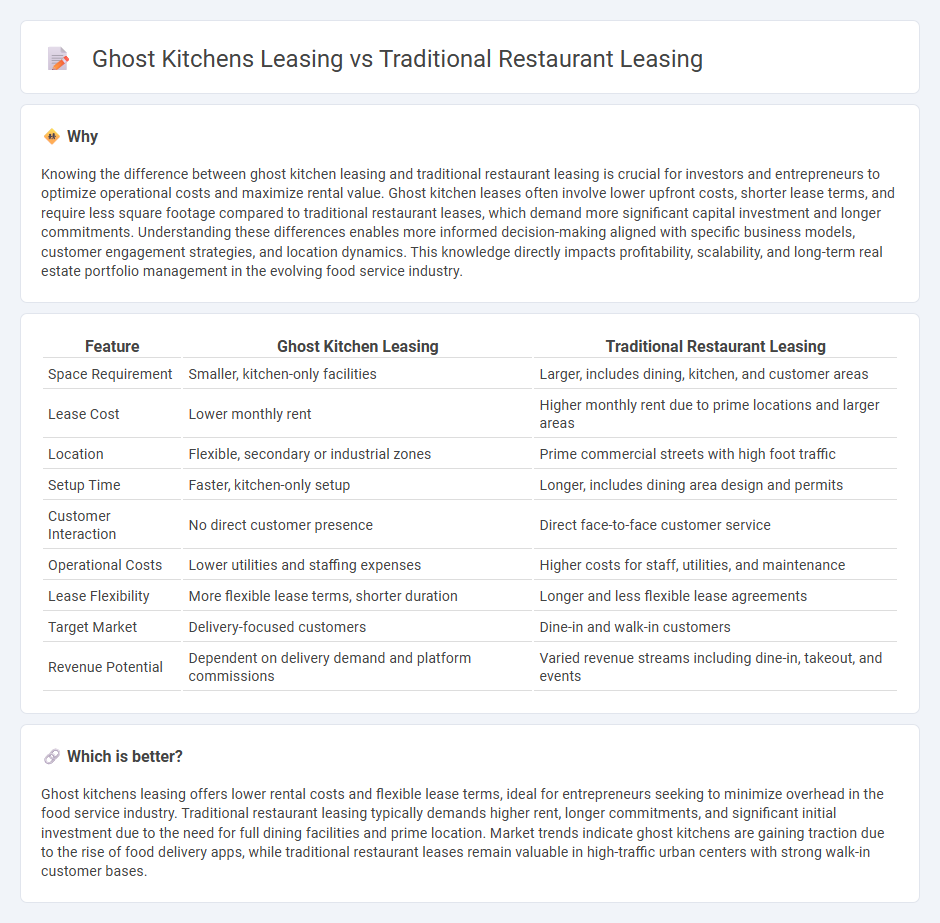
Ghost kitchens offer lower leasing costs and flexible terms compared to traditional restaurant spaces, making them ideal for delivery-focused food businesses. Unlike conventional restaurants, ghost kitchens require less square footage and do not need prime storefront locations, significantly reducing overhead expenses. Explore the key differences and benefits of ghost kitchen leasing versus traditional restaurant leasing to optimize your real estate strategy.
Why it is important
Knowing the difference between ghost kitchen leasing and traditional restaurant leasing is crucial for investors and entrepreneurs to optimize operational costs and maximize rental value. Ghost kitchen leases often involve lower upfront costs, shorter lease terms, and require less square footage compared to traditional restaurant leases, which demand more significant capital investment and longer commitments. Understanding these differences enables more informed decision-making aligned with specific business models, customer engagement strategies, and location dynamics. This knowledge directly impacts profitability, scalability, and long-term real estate portfolio management in the evolving food service industry.
Comparison Table
| Feature | Ghost Kitchen Leasing | Traditional Restaurant Leasing |
|---|---|---|
| Space Requirement | Smaller, kitchen-only facilities | Larger, includes dining, kitchen, and customer areas |
| Lease Cost | Lower monthly rent | Higher monthly rent due to prime locations and larger areas |
| Location | Flexible, secondary or industrial zones | Prime commercial streets with high foot traffic |
| Setup Time | Faster, kitchen-only setup | Longer, includes dining area design and permits |
| Customer Interaction | No direct customer presence | Direct face-to-face customer service |
| Operational Costs | Lower utilities and staffing expenses | Higher costs for staff, utilities, and maintenance |
| Lease Flexibility | More flexible lease terms, shorter duration | Longer and less flexible lease agreements |
| Target Market | Delivery-focused customers | Dine-in and walk-in customers |
| Revenue Potential | Dependent on delivery demand and platform commissions | Varied revenue streams including dine-in, takeout, and events |
Which is better?
Ghost kitchens leasing offers lower rental costs and flexible lease terms, ideal for entrepreneurs seeking to minimize overhead in the food service industry. Traditional restaurant leasing typically demands higher rent, longer commitments, and significant initial investment due to the need for full dining facilities and prime location. Market trends indicate ghost kitchens are gaining traction due to the rise of food delivery apps, while traditional restaurant leases remain valuable in high-traffic urban centers with strong walk-in customer bases.
Connection
Ghost kitchens and traditional restaurant leasing intersect through their shared reliance on strategic commercial real estate locations optimized for food service operations. Both models necessitate spaces equipped with essential kitchen infrastructure, compliance with health regulations, and sufficient utilities, yet ghost kitchens typically require smaller footprints in high-demand delivery zones. Real estate investors and developers increasingly recognize the value in flexible leasing arrangements that accommodate the evolving dynamics between dine-in experiences and delivery-only food production.
Key Terms
**Traditional Restaurant Leasing:**
Traditional restaurant leasing involves securing a physical dining space, often requiring long-term contracts and significant upfront costs for build-out, equipment, and decor tailored to brand identity. These leases typically cover prominent street locations with high foot traffic, contributing to consistent walk-in customer volume and local visibility. Explore the nuances of traditional restaurant leasing to make informed decisions about your culinary business setup.
Prime Location
Traditional restaurant leasing demands premium real estate in high-traffic areas to attract walk-in customers, leading to higher rent costs but increased visibility and brand presence. Ghost kitchen leasing prioritizes cost-efficiency over location, often situated in lower-rent industrial zones or suburban areas since they rely on delivery rather than foot traffic. Explore the strategic benefits and financial impacts of prime location choices in restaurant leasing to optimize your business model.
Front-of-House Space
Traditional restaurant leasing demands substantial investment in front-of-house space, including dining areas, decor, and customer seating, directly influencing rental costs and operational expenses. Ghost kitchens eliminate the need for front-of-house space, focusing solely on kitchen facilities, which significantly reduces leasing fees and enhances scalability for delivery-only services. Explore the advantages of each model to optimize your restaurant leasing strategy.
Source and External Links
How to Lease a Restaurant: The Ultimate Guide - This guide provides comprehensive insights into restaurant leasing, including various lease types and negotiation strategies.
Leasing Restaurant Space: What to Know When Renting in... - The article discusses key considerations for leasing restaurant space, such as rent as a percentage of gross sales and different lease types.
Restaurant Realty Company - Specializes in restaurant and bar leasing, offering extensive experience and a wide range of services for clients in the hospitality industry.
 dowidth.com
dowidth.com